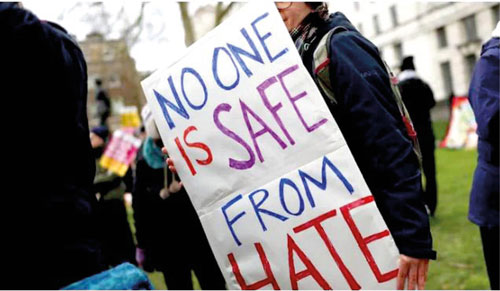The British government released its latest hate crime statistics for England and Wales (2021-22) with the key finding that hate crimes recorded by the police have increased by 26% in the year ending March 2022 compared with the previous year.
It is important to note the caveat that it is not clear if this represents a “genuine rise,” both because there have been significant improvements in the way the police record crime and victims also may have greater confidence in reporting such crimes to the police.
These statistics provide a vital insight into the patterns and most common forms of hostility in England and Wales towards someone based on particular personal characteristics (race, religion, sexual orientation, disability, and transgender identity).
But to gather a holistic picture, these hate crime statistics must be set within the context of wider trends in hostility and prejudice reflected in media narratives, social media use and political discourse.
Of a total of 155,841 offences recorded by the police, the monitored strands of hate crime, starting with the most common first, were race (109,843), sexual orientation (26,152), disability (14,242), religion (8,730) and transgender (4,355).
These numbers exceed the total offences because some crimes can have more than one motivating factor.
The trends are quite different when the focus is on increase since the previous year. In descending order, transgender hate crimes have increased by 56%, disability by 43%, sexual orientation by 41%, religion by 37% and race by 19%.
The report states that these annual increases are in part because of lower crimes recorded during the periods of COVID-19 restrictions, but that there may have been an increase in hate crimes against transgender people because of increased discussion on social media around transgender issues.
The UK has often been regarded as one of the safest countries worldwide for sexual minorities, and so the sharp increase in related hate crimes is a reminder that more has to be done to tackle such prejudices, even if they are taken seriously by the authorities.
While the report states that there may have been lower recorded crimes during the COVID-19 lockdowns, racist and religiously discriminative media narratives must be acknowledged.
Muslims, in particular, around the world were scapegoated for allegedly exacerbating transmission of the virus during Ramadan, and Muslims in the UK were no exception sadly.
In an analysis of four mainstream British newspapers, Elizabeth Poole and Milly Williamson suggested that Muslims in the UK were once again dichotomised into “good versus bad Muslim/immigrant,” with Muslim key workers presented as the “good” Muslim/immigrant versus “other Muslims.”
They also extend their analysis to how these newspapers present Muslims in other countries, often using images of “mass gathering of Muslims, particularly in the build-up to Ramadan.”
For example, one reported that “Pakistan’s government has struggled to enforce social distancing rules at mosques and religious gatherings.”
Such images are reminiscent of the colonial and orientalist sentiments that remain today, portraying Muslims as an unruly mass.
The report’s statistics confirm that Muslims were also targeted the most in religious hate crimes in the year ending March 2022. Where the perceived religion and the religion of the victim might not always be the same, but the perceived religion is the one recorded, the most targeted religious group was Muslims at 42% of religious hate crime offences.
In the previous year, attacks against Muslims were also the most common at 45%. Though the percentage has decreased, there were 756 more recorded attacks against Muslims this year.
The second most targeted religious group was Jewish people again at 23% of religious hate crimes, followed by Christians at 8% and Sikhs at 4%.
As with last year’s report, spikes in racially and religiously aggravated offences have been identified following specific events.
These were after the EU Referendum in the summer of 2016, the terrorist attacks of 2017 and the Black Lives Matter protest in the summer of 2020 after the death of George Floyd. A fourth spike has been identified in the summer of 2021, put down not to specific events as above, but described largely as an “increase of racially or religiously aggravated public fear, alarm or distress offences”.—Reuters










